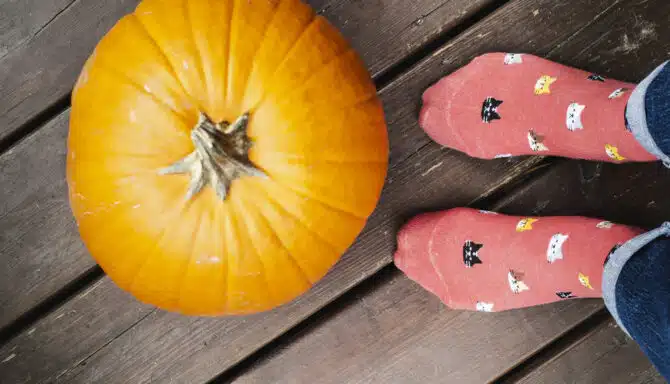October 28, 2024
Taking care of your feet during winter might require a little extra effort, but it’s essential for preventing discomfort and long-term issues. The cold weather can impact your feet in its own unique ways, just like hot weather can. Whether you’re dealing with dry, cracked skin or trying to avoid slippery conditions, being mindful of your foot health will keep you a step ahead of the cold.
5 Ways Cold and Wet Weather Can Impact Your Feet
Dry, cracked skin
Skin conditions
Reduced circulation
Stiffness and joint pain
Winter-related foot conditions
1. Dry, Cracked Skin
https://www.youtube.com/watch?v=1-Sf43woLLE
One of the first things you may notice during the winter is dry, cracked skin on your feet, especially your heels.
The chilly air and low humidity can quickly sap the moisture from your skin, leaving your feet feeling rough and sore. Heating indoors doesn’t help either, as it dries out the air, exacerbating the issue.
This is where cold weather foot care enters the picture! Since cracked skin can cause pain and even bleed, it becomes essential to protect your feet. This dryness isn’t just unsightly—if the cracks open up, it creates an easy pathway for infections. This can lead to debilitating pain and bleeding that makes walking difficult.
Regular moisturizing with a medical-grade foot cream is a straightforward way to combat dry feet and cracked heels. Look for products that contains a high urea concentration, which will help your skin replenish and retain lost moisture. It's important to use a foot cream instead of a regular moisturizer for your feet because the skin on your feet is thicker than the skin elsewhere on our body. Therefore, a regular body or facial moisturizer won't cut it - especially during the dry, colder months.
While you're at it, take your hydration to the next level by always remembering to drink your eight glasses of water per day. This advice still holds up today!
2. Reduced Circulation
Cold weather can mess with your blood flow, which can pose a problematic obstacle for foot health. When temperatures drop, blood vessels constrict to preserve heat, meaning less blood flows to your extremities. This is called vasoconstriction.
As a result, your feet may feel cold, numb, or even tingly. Poor circulation can also lead to prolonged healing times for cuts or blisters. This is concerning for diabetes patients with neuropathy who are already struggling with wound healing issues. That's why cold weather diabetic foot care should always include steps to monitor and improve blood flow— including daily foot inspections and easy foot exercises.
Wearing thermal socks and ensuring your feet are properly insulated can help combat the impact of reduced circulation. Just make sure your thermal socks fit comfortably with your fall and winter footwear: if your shoes or boots are too tight, it will reduce circulation and make your feet more susceptible to cold-weather complications (more on that below).
If you experience slippery conditions during winter, circulation issues can also increase your risk of falling or slipping. When your feet are numb, it’s harder to get a good sense of balance, so be cautious and wear shoes with good grip for FALL prevention.
Moving around can also help keep your blood flowing. So, if you’re out and about, take small breaks to wiggle your toes and stretch to maintain circulation. There are even targeted foot exercises you can try to help trigger healthy blood flow. In fact, you should do these more often in the winter than the summer.
3. Skin Conditions
https://www.youtube.com/shorts/xZ4RQwPmCzg
It might seem strange to consider blisters a winter problem, but they can definitely crop up due to cold weather foot care challenges.
Wearing heavy boots and thick socks can cause friction, leading to blisters on your heels or toes. This is why it’s extremely important for boots to fit snugly, but not be too tight. So if the socks you like to wear in the winter are causing your boots to constrict your feet, they don’t fit!
And if your feet are already dry, cracked, or dealing with reduced circulation, they’re even more susceptible to developing painful blisters. Combat this by ensuring your boots and sock combo always fit perfectly together, and opt for moisture wicking socks to go the extra mile.
Another common winter foot problem is athlete's foot. Though often associated with the hot summer months and public swimming pools, athlete's foot is no stranger to winter either. Athlete's foot thrives in wet, damp areas, so instead of crowded public summer pools, fungal infections change their habitat to the wet-from-the-snow environment inside your boots. And keep in mind, you can get athlete’s foot simply by coming into contact with someone who already has it.
When you’re tackling wet feet, whether it’s from snow or rain, you need to dry them thoroughly before putting on warm socks. Athlete’s foot loves moist environments, so making sure your feet are dry is key. If you start to notice itchy or peeling skin between your toes, it’s a sign that athlete's foot might be setting in. Treat it promptly with your Toronto chiropodist, who can provide the right antifungal products. Make sure you also keep your feet clean and dry and avoid sharing shoes and socks to protect your feet from a future infection.
4. Stiffness and Joint Pain
https://www.youtube.com/shorts/n46k32OZgco
Cold weather tightens your muscles, which in turn can lead to stiff joints. This discomfort can be particularly noticeable if you already have arthritis or any other joint-related issues. Without the right cold weather foot care, your feet can end up feeling stiff, which can affect your overall mobility. To help counteract this, regular stretching and low-impact exercises, such as foot rotations, can keep your joints limber.
This season also requires some extra attention to footwear. Choose shoes with ample support to keep your feet cushioned against the impact of walking on hard, cold surfaces. Slippery conditions can further aggravate joint pain because your body works overtime to stay balanced, putting extra pressure on your feet. Adding orthotics or insoles that provide added arch support can also reduce some of this strain and make your steps feel more cushioned and less jarring.
5. Winter Related Foot Conditions
Winter brings its own set of unique foot problems, including chilblains, frostbite, and Raynaud’s disease, all of which can make cold weather foot care a bit trickier.
Chilblains occur when your feet are exposed to cold, damp environments, causing painful, itchy red patches. This is particularly common in teenagers, or people who quickly reheat their feet after being in the cold, so it’s best to warm up slowly.
Frostbite is another concern in extreme cold, as it can severely damage your skin and tissues. Frostbite can occur more quickly than you might expect, especially if you don't protect your feet from the weather. Signs of frostbite include numbness, skin discolouration, and a hard, waxy texture. If you think you may be experiencing frostbite, it’s essential to seek medical help immediately. To prevent frostbite, be sure to layer up and wear weatherproof boots that keep your feet dry and warm.
Lastly, Raynaud’s disease can be exacerbated by cold weather. People with Raynaud’s experience an exaggerated response to cold, which restricts blood flow to the toes, leading to reduced circulation and making your feet even more vulnerable. Keeping your feet constantly warm and avoiding sudden temperature changes can help manage Raynaud’s symptoms, but if you experience persistent pain or numbness, you should consult a healthcare provider.









